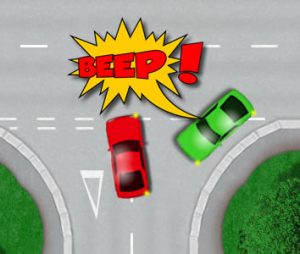For some, passing the driving test seems like an insurmountable challenge and with driving test pass rates at a 10 year low, learner drivers are looking for all the confidence they can get. Although the driving test changed in late 2017, the most common reasons for failure have remained very similar. Being familiar with the common pitfalls that many test candidates replicate year-on-year, may assist you with some knowledge to self-asses your driving and to make improvements. Let’s look at the top 10 most common reasons to fail the driving test and the reasons why.
Observation at Junction
Poor observation at junctions is at the top of the list year-on-year. A learner will record a fault typically by emerging from a junction without taking effective observation before doing so. The reasons why this happens is usually because:
- Approach speed – the speed at which you approach the junction is crucial. Assess the junction in good time before you reach it. If it looks ‘closed’ (surrounded by houses, hedges, fences etc), then approach it slower than if it’s open. This will allow you more time to observe and to position yourself at the junction line correctly.
- Take enough time – to observe. Many learners feel that they are being to slow at junctions and don’t want to be seen as too hesitant. Always look in both directions at least twice before proceeding over the junction line. If you’re not confident about emerging, then don’t – wait until you are.
- Observe everything – it’s quite easy to focus on only what you’re expecting and that’s cars. A common test failure is not noticing that pedestrian crossing the road or the cyclist who’s approaching.
Further Information
- Learn about junctions.
Use of Mirrors
To be specific, this is a failure to use mirrors or use them correctly when changing direction. The most common reasons for failing the test are:
- The test candidate has forgotten to check mirrors before changing direction.
- The test candidate checked the mirrors whilst changing direction. Remember, you must check the appropriate mirrors before changing direction and not during.
Further Information
- Learn about use of mirrors.
Control of the Vehicle
Specifically, this is control of the vehicle in terms of steering. This isn’t necessarily in relation to how you hold the steering wheel as examiners are quite relaxed about where you place your hands on the wheel (these days). That is, not unless it affects the control of the vehicle of course. An example of this fault would be if you were to make a right turn and cut the junction line of the road you’re turning into, or hit or mount a kerb whilst driving. The most common reasons for failing the test are:
- The test candidate steers inaccurately causing them to travel off course.
- The test candidate momentarily removed both hands from the steering wheel.
- The test candidate allows the steering wheel to self-centre too freely where is affects control.
Further Information
- Learn about steering technique.
Turning Right at Junctions
Always making it into the most common reasons to fail the driving test is bad positioning when turning right at a junction. Always position your vehicle to the left of the centre line and stop just before the junction line.

The most common reasons for failing the test are:
- Lack of observation.
- Test candidate approaching junction to fast, not allowing enough time too position the vehicle.
Further Information
- Learn about turning right at a junction.
Moving Off (Safely)
Moving off simply requires the learner driver moving off from a stationary position at the side of the road. Quite a simple procedure but also easy to get wrong if you forget something. It requires getting the car ready, observation and if necessary, a signal and it’s a procedure that examiners like to see frequently. The most common reasons for failing the test are:
- The test candidate forgets to check the blind spot.
- There is a delay with moving off and the test candidate fails to make sufficient safe observations for a second time before moving off.
Further Information
- Learn about moving off.
Response to Signals (Traffic Lights)
Some sets of traffic lights can be a little confusing, especially at complex junctions where you’re faced with multiple lights. The most common reasons for failing the test are:
- The test candidate fails to respond to a green filter light and remains stationary.
- Not conforming to a red light.
- Failing to respond correctly to an amber light.
- Stopping beyond an advanced stop line (the area designated for cyclists).
Further Information
- Learn about traffic lights.
Move off (control)
Here we’re back to moving off again and this time it relates to control of the vehicle. You’ll need to prepare the vehicle ready for moving off, observe and signal if necessary. The most common reasons for failing the test are:
- Continuous stalling the vehicle demonstrates a lack of control. Stalling once or twice during the test isn’t usually an issue, but constantly doing so, or stalling in a dangerous position might see you fail.
- Attempting to move off with the hand brake on (though this should be okay of you realise quickly enough).
- Allowing the vehicle to roll backwards if moving off on a slope.
Further Information
- Learn about moving off.
Positioning (Normal Driving)
This is the issue of the test candidate failing to position correctly for the route they’re taking. The most common reasons for failing the test are:
- Straddling lanes.
- Driving too far or too close to the kerb.
- Failing to keep the correct road position on a roundabout.
- Driving too close to parked cars or cyclists.
Further Information
- Learn about road positioning and lane discipline.
Response to Signals (Road Markings)
This is where you fail to abide by road markings whilst driving. There are numerous reasons why test candidates may fail for this, but the most common reasons for failing the test are:
- Unnecessarily crossing a solid white line in the centre of the road.
- Unnecessarily entering a cycle or bus lane when it’s prohibited.
- Failing to follow directional arrows.
- Stopping in a yellow box junction when your exit is not clear.
Further Information
- Learn about road markings.
Reverse Park (Control)
Driving test manoeuvres fill some test candidates with dread due to the high level of accuracy involved. This final common test failure is due to vehicle control, though a lack of sufficient observation also fails many tests during manoeuvres. Reverse parking includes parallel parking or reversing into a bay. The most common reasons for failing the test are:
- Hitting or mounting kerbs.
- Finishing the manoeuvre whilst not within the lines (bay parking) or too far away from the kerb (parallel parking).
Further Information
- Learn about parallel parking and reverse bay parking.

